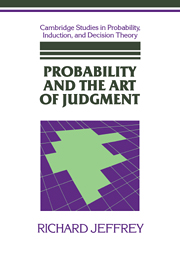Book contents
- Frontmatter
- Contents
- Preface
- 1 Introduction: Radical probabilism (1991)
- 2 Valuation and acceptance of scientific hypotheses (1956)
- 3 Probable knowledge (1968)
- 4 Probability and the art of judgment (1985)
- 5 Bayesianism with a human face (1983)
- 6 Alias Smith and Jones: The testimony of the senses (1987)
- 7 Conditioning, kinematics, and exchangeability (1988)
- 8 Preference among preferences (1974)
- 9 On interpersonal utility theory (1971)
- 10 Remarks on interpersonal utility theory (1974)
- 11 Mises redux (1977)
- 12 Statistical explanation vs. statistical inference (1969)
- 13 New foundations for Bayesian decision theory (1965)
- 14 Frameworks for preference (1974)
- 15 Axiomatizing the logic of decision (1978)
- 16 A note on the kinematics of preference (1977)
5 - Bayesianism with a human face (1983)
Published online by Cambridge University Press: 05 June 2012
- Frontmatter
- Contents
- Preface
- 1 Introduction: Radical probabilism (1991)
- 2 Valuation and acceptance of scientific hypotheses (1956)
- 3 Probable knowledge (1968)
- 4 Probability and the art of judgment (1985)
- 5 Bayesianism with a human face (1983)
- 6 Alias Smith and Jones: The testimony of the senses (1987)
- 7 Conditioning, kinematics, and exchangeability (1988)
- 8 Preference among preferences (1974)
- 9 On interpersonal utility theory (1971)
- 10 Remarks on interpersonal utility theory (1974)
- 11 Mises redux (1977)
- 12 Statistical explanation vs. statistical inference (1969)
- 13 New foundations for Bayesian decision theory (1965)
- 14 Frameworks for preference (1974)
- 15 Axiomatizing the logic of decision (1978)
- 16 A note on the kinematics of preference (1977)
Summary
WHAT'S A BAYESIAN?
Well, I'm one, for example. But not according to Clark Glymour (1980, pp. 68–69) and some other definers of Bayesianism and personalism, such as Ian Hacking (1967, p. 314) and Isaac Levi (1980, p. xiv). Thus it behooves me to give an explicit account of the species of Bayesianism I espouse (sections 1 and 2) before adding my bit (section 3, with lots of help from my friends) to Daniel Garber's (1983) treatment of the problem of new explanation of common knowledge: the so-called problem of old evidence.
With Clark Glymour, I take there to be identifiable canons of good thinking that get used on a large scale in scientific inquiry at its best; but unlike him, I take Bayesianism (what I call “Bayesianism”) to do a splendid job of validating the valid ones and appropriately restricting the invalid ones among the commonly cited methodological rules. With Daniel Garber, I think that bootstrapping does well, too – when applied with a tact of which Bayesianism can give an account. But my aim here is to elaborate and defend Bayesianism (of a certain sort), not to attack bootstrapping. Perhaps the main novelty is the further rounding-out in section 3 (by John Etchemendy, David Lewis, Calvin Normore, and me) of Daniel Garber's treatment of what I have always seen as the really troubling one of Clark Glymour's strictures against Bayesianism. After that there is a coda (section 4) in which I try to display and explain how probability logic does so much more than truth-value logic.
- Type
- Chapter
- Information
- Probability and the Art of Judgment , pp. 77 - 107Publisher: Cambridge University PressPrint publication year: 1992
- 5
- Cited by

